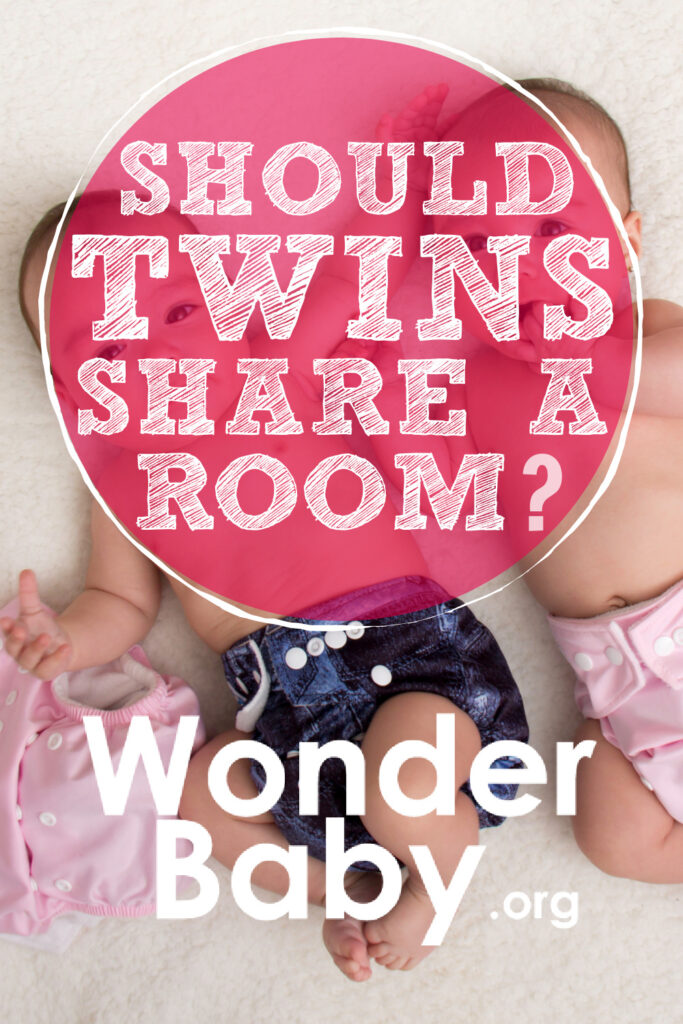Should Twins Share a Room?

- Having twins share a room has various benefits, including saving space, bonding and emotional security, and synchronizing bedtime routines.
- While there are cons to twins sharing a room, there are several tactics to help your children successfully share a room.
- You may decide to separate your twins around ages 10 to 12, when they’re going through adolescence.
As kids, my siblings and I shared rooms. I’m one of four, and there wasn’t enough space for us all to have our own rooms. At the time, I groaned, but looking back, I can see the advantages. It’s also a place in time that I won’t get back, so I remember it fondly.
Reflecting on my own childhood, I can see the benefits of sharing a room with my siblings. But it wasn’t all smooth sailing.
If you’re a parent of twins, sharing a room might seem like the most logical choice. But should twins share a room? It’s a tricky question to answer because there are both pros and cons.
While we’ll provide insight into whether twins should share a room, remember that you ultimately know what’s best for your family.
Pros of Twins Sharing a Room

The good news is there are several reasons why you’ll love your twins sharing a room. For one, it clears up that room you’ve been wanting to turn into your dream craft room or home office. (Or is that just me?)
But, putting you aside (yep, it happens sometimes when you have kids), having your twins share a room can lead to many positive results.
Let’s look closely at some pros of having twins share a room.
Bonding and Emotional Security
Twins often have a strong bond, and sharing a room can reinforce their emotional connection. Being close can provide comfort and reduce separation anxiety, especially at bedtime. (Which is important when you’re ready to go to bed!)
A 2010 study by Castiello et al. found that twin fetuses execute movements11. Castiello, U., Becchio, C., Zoia, S., Nelini, C., Sartori, L., Blason, L., D’Ottavio, G., Bulgheroni, M., & Gallese, V. . Wired to be social: The Ontogeny of Human Interaction. PLoS ONE. 2010;5(10). https://doi.org/10.1371/journal.pone.0013199 specifically aimed at the co-twin starting from the 14th week of gestation.
That’s incredible! Naturally, there is a huge advantage to having your twins share a room. (As a side note, I love seeing the ultrasound photos of twins holding hands!)
Space-Saving
Having your children share a room saves space, especially if you don’t have much to begin with. It also maximizes available space, leaving room for other activities or storage.
Even if you have an extra bedroom, it doesn’t mean your twins can’t share a room. Instead, you can use the additional space as a playroom or guest room. I’m a big advocate of doing what works best for your family.
Routine and Sleep Synchronization
When twins share a room, they can (hopefully!) develop similar sleep schedules. This can make bedtime routines more manageable for parents, as both children can go to bed simultaneously instead of racing back and forth between two bedrooms.
Even if your twins don’t have the same sleep schedule, you can get the other used to the difference to help them adapt.
Learning to Share and Cooperate
When twins share a room, they learn to negotiate and share space, toys, and other resources. This fosters critical social skills like cooperation, compromise, and respect for personal boundaries.
It’s an excellent opportunity to work on cooperative play, which focuses on children communicating, interacting, and playing collaboratively with others.
Cons of Twins Sharing a Room

I wish I could say that twins sharing a room only comes with positive side effects, but there are some things to consider. Remember, you can always work around any cons listed to ensure your twins have a positive experience sharing a room.
Let’s take a look at considerations when bunking your twins together.
Sleep Disturbances
One of the biggest cons of having twins share a room is the potential for sleep disturbances. Let’s say one twin has trouble sleeping (e.g., wakes up frequently or snores); this can disturb the other, leading to poor sleep for both.
Sleep schedules may not always align, especially as twins grow older, so this is something to consider. However, sleep training twins may help avoid potential sleep disturbances while getting them on the same schedule.
Healthy sleep is vital for kids, and getting enough is essential. For example, 3 to 5-year-olds should get 10–13 hours of sleep22. Healthy sleep for your baby and child. Caring for kids. 2018. https://caringforkids.cps.ca/handouts/pregnancy-and-babies/healthy_sleep_for_your_baby_and_child nightly.
Developmental Differences
When rooming your twins together, consider whether one twin reaches developmental milestones faster. For example, one may drop naps sooner than the other, preventing one twin from being in the room while the other sleeps.
As they age, they may develop different study habits, which could cause friction if they are forced to follow the same routines despite their differing needs.
In addition, children eventually go through puberty, which could come at different times. It’s essential to be flexible as your children grow and develop.
Less Individuality
Sharing a room can make it harder for twins to express their unique identities. Room decor, organization, and personal belongings may be less individualized, potentially limiting self-expression.
In addition, sharing a room sometimes makes it challenging to develop a sense of ownership because everything is considered communal. (Don’t worry—I’ll go over some tips to address this!)
Conflict Over Sharing
While room-sharing can teach cooperation, it can also lead to arguments over toys, space, or control of the environment (i.e., lighting or temperature). In addition, when twins have varying personalities and needs, they may clash over how to use the room.
For example, one twin may prefer a quiet space, while the other enjoys having friends over or playing loud music.
If you’re concerned about your twins sharing a room, I recommend getting a good baby monitors for twins so you can easily keep an eye on things.
5 Tips for Successfully Sharing a Room

Although some problems can arise when twins share a room, these tips and tricks can help keep everyone happy:
1. Create Individual Spaces
Creating personal areas for each child is vital, even within a shared room. For example, you can give each twin a shelf or corner they can personalize. Remember to let them choose their decor, bedding, or small items that reflect your twins’ individuality.
In addition to this, you can assign separate parts of the room (although I don’t think you need to tape down the floor!). Respecting their preferences and allowing them the freedom to express themselves is important.
2. Establish Routines and Boundaries
Siblings will fight, but teaching your twins to respect each other’s space and belongings is crucial. I also recommend clearly defining shared areas and areas that belong to each individual twin to help reduce conflicts over territory.
In addition, a consistent routine helps minimize disruptions and creates a more peaceful environment. Remember, you may have to adjust your routine as your kids age or add extra activities to the calendar.
3. Coordinate Sleep Schedules
It’s best to try to align twins’ bedtimes and wake-up times as much as possible, which is easier said than done. However, having a consistent bedtime routine for both twins promotes healthy sleep habits and lowers the chances of one twin waking up the other.
It also saves you time when both twins are on the same sleep schedule by preventing two separate bedtime routines.
4. Monitor and Adjust as Needed
As your twins age, their needs will change. It’s best to be prepared to adapt the room layout or arrangements based on these changes, such as providing more privacy, space for study, or quiet time.
If the room is large enough, consider adding room dividers or curtains, as they create a sense of separation and privacy while sharing a room. I like this 4 Panel 5.6 Ft Tall Partition Wood Room Divider because it has shelves, allowing your twins to personalize it.
- Flexible Panels: Made out of Wood, 5.6 ft. tall, 16″ wide each panel gives supports in flexibility and functionality in daily use.
- Made Sturdier: Hinged panels unpack and set up easily while the lightweight is work for ladies.
- Nice Looking: Designed to look equally attractive from front or back.
- Superb Craftsmanship: Flawless Louvered slat design allows light and air to pass through, aslo helps in long lasting.
5. Use Headphones or White Noise
I require white noise when I sleep, but it’s also beneficial when twins share a room. For example, if one twin is noisier than the other, white noise machines or headphones minimize disruptions and help create a harmonious environment.
I’m a fan of the Babelio Mini Sound Machine for older kids because it’s small and comes in various colors, making it easy to transport.
- POCKET WHITE NOISE MACHINE: Measuring just 1.89×1.89×1.57 inches, the tiniest white noise machine on the market! Fits easily in your pocket and can be carried anywhere
- 15 NON-LOOPING SOUNDS: Including white noise, pink noise, brown noise, fan sound, rain, waves, insects, campfire, birds, streams, etc. Small in size, but rich in options
- Timer & Memory Function: Short press the switch button to select the timer.In addition, the noise maker has the memory function which can automatically remembers your previous sound, volume and timer
- ELEGANT DESIGN: Stylish and simple, easy to operate. Suitable for all ages, including babies, kids, adults, seniors, allowing you to have a good sleep or focus enviroment
FAQs
What are the best strategies for decorating a shared room for twins?
It’s important for you to allow your twins to express their decorating preferences while setting up their bedrooms. If space is provided, it will enable them to create personal spaces that the other twin isn’t permitted in.
You can also maximize storage by keeping bins under their beds or consider loft beds, which free up space underneath.
At what age should twins stop sharing a room for personal space?
The ideal age for twins to stop sharing a room will vary based on their individual personalities, developmental needs, and family circumstances.
However, you may decide between the ages of 10 and 12 that it’s time to separate your twins. At this age, they’ll likely prefer more privacy as they form their own identities.
References
- Castiello, U., Becchio, C., Zoia, S., Nelini, C., Sartori, L., Blason, L., D’Ottavio, G., Bulgheroni, M., & Gallese, V. (2010). Wired to be social: The Ontogeny of Human Interaction. PLoS ONE, 5(10). https://doi.org/10.1371/journal.pone.0013199
- Healthy sleep for your baby and child. Caring for kids. (2018, December). https://caringforkids.cps.ca/handouts/pregnancy-and-babies/healthy_sleep_for_your_baby_and_child

Related Posts

Development, Special Needs
How to Track Milestones for Developmentally Delayed Babies
Parents of developmentally delayed babies can explore practical tools and strategies to track milestones, celebrate progress, and support their child’s unique developmental journey.

Fine and Gross Motor
5 Alternatives to Tummy Time for Babies with Motor Development Challenges
Does your baby struggle with tummy time due to motor development challenges? These alternatives to tummy time will offer the same benefits.

Fine and Gross Motor
Understanding Hypotonia & Hypertonia: What Parents Need to Know
Altered muscle tone can affect your child’s development. Learn more about ways you can help your child by understanding hypertonia and hypotonia.

